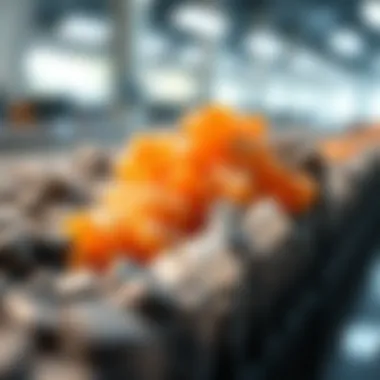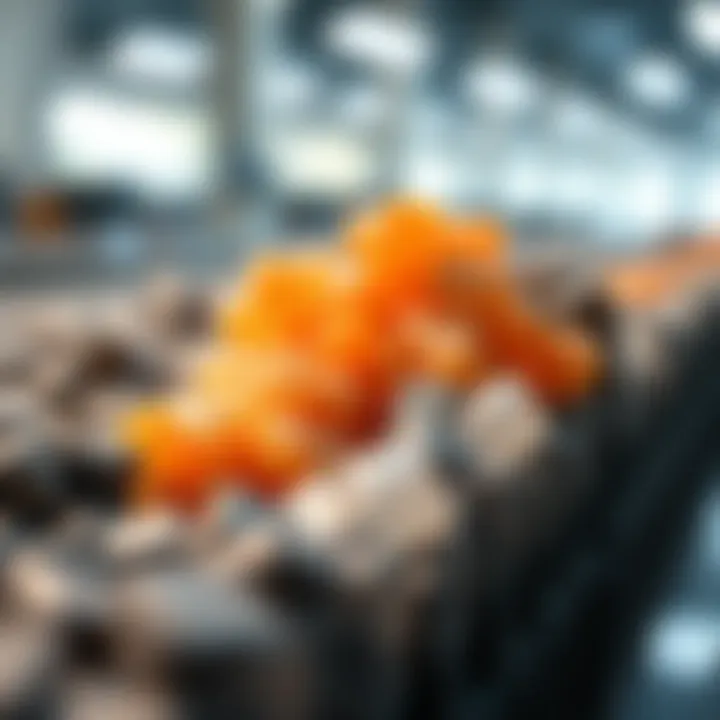Ion Exchange Wastewater Treatment: Key Mechanisms and Future Outlook


Intro
The management of water resources has become a pressing need in today's world. As industries grow and cities expand, the demand for clean water increases, raising concerns about the wastewater generated in these processes. One effective method for tackling this issue is through ion exchange, a technique that removes unwanted ions from water, replacing them with more benign counterparts. This approach is not only vital for protecting the environment but also for ensuring public health and safety.
Understanding ion exchange wastewater treatment means peeling back the layers of its mechanisms and how they apply to various fields such as environmental science, chemical engineering, and municipal water management. The sheer versatility of this technique makes it relevant across different disciplines, sparking interest among students, researchers, and professionals alike.
Here's an overview of what lies ahead in this article: we will delve into the purpose of this technology, trace its historical roots, unpack key concepts, and explore contemporary advancements that promise to reshape how we manage wastewater effectively and sustainably. In doing so, we aim to provide a comprehensive guide for anyone eager to understand this crucial aspect of water treatment.
Preface to Ion Exchange
In today's world, water quality has taken center stage, with communities and industries alike paying more attention to how wastewater is treated before being discharged back into the environment. Among various methods for water purification, one approach—ion exchange—stands out for its versatility and effectiveness. This process involves a fascinating shift of ions that can effectively remove unwanted contaminants, making it a critical tool in modern wastewater management.
Definition and Historical Context
Ion exchange is, at its core, a reversible chemical reaction where an ion from a solution is replaced with another ion that is attached to an insoluble solid, usually a resin. Traditionally, this concept has been around for decades, gaining traction alongside the burgeoning awareness surrounding pollution and the necessity of clean water. The roots trace back to the mid-20th century when early studies explored the potential of using ion-exchange techniques to treat drinking water and industrial effluents. Over time, as technology evolved, so did the designs and applications of ion exchange systems, with continuous improvements being made to increase efficiency and reduce costs.
The significance of ion exchange is not just in its historical context, but also in its application across various sectors today. Its dual nature as both a purification and separation process means it is utilized in numerous fields, from municipal water treatment plants to complex industrial processes, thus sealing its place in wastewater treatment history.
Importance in Wastewater Treatment
The importance of ion exchange in wastewater treatment cannot be overstated. Here’s why:
- Efficient Contaminant Removal: Ion exchange is adept at removing specific ions, such as heavy metals and excess nutrients, which might otherwise lead to environmental degradation or health issues when released untreated.
- Flexibility and Adaptability: This technique can be tailored to address specific challenges in wastewater streams. Whether it’s a high concentration of certain contaminants or variations in water chemistry, ion exchange systems can be adjusted accordingly.
- Cost-Effective Solutions: Compared to other methods, such as reverse osmosis, ion exchange can be more economical, particularly when dealing with moderate contaminant levels. It often requires less energy, making it an attractive option for municipalities and industries alike.
"Water is life, and clean water is crucial for sustainable living. Ion exchange plays a pivotal role in ensuring that the water we consume is safe and free from harmful pollutants."
"Water is life, and clean water is crucial for sustainable living. Ion exchange plays a pivotal role in ensuring that the water we consume is safe and free from harmful pollutants."
In summary, the dialogue surrounding wastewater treatment would be incomplete without the mention of ion exchange. Its capacity to effectively manage wastewater not only aids in safeguarding human health but also plays a part in protecting ecological systems from potential hazards associated with contaminated water discharge. As we continue to explore the mechanics behind ion exchange, we gain a greater appreciation of its role in the broader context of water management and environmental sustainability.
Mechanisms of Ion Exchange
Understanding the mechanisms of ion exchange is vital for grasping how this technology impacts wastewater treatment. This section sheds light on the intricacies of how ions swap places to facilitate the removal of harmful contaminants from water. By delving into the basic principles and types of reactions involved, one gains a clearer view of the operational tactics that define efficient treatment systems. This understanding of ionic interactions is essential for optimizing processes, designing effective treatment systems, and advancing technological innovations in the field.
Basic Principles of Ion Exchange
At its core, ion exchange hinges on a straightforward principle: ions in a solution are exchanged for ions bound to a resin. Think of it as a dance where the dancers (ions) switch partners to create a more harmonious arrangement. This operation cleverly capitalizes on the similarities in charge and size between the ions involved. For instance, a positively charged ion in wastewater might swap places with a positively charged ion on the resin, effectively removing contaminants from the liquid.
"Ion exchange is a meticulous balancing act, where the right ions take center stage, leaving impurities out of the limelight."
"Ion exchange is a meticulous balancing act, where the right ions take center stage, leaving impurities out of the limelight."
In practical terms, the effectiveness of ion exchange depends on various factors, including the concentration of ions, the capacity of the resin, and the solution's overall chemistry. The process is continuous and can be finely tuned for optimal performance depending on the specific contaminants present in wastewater.
Types of Ion Exchange Reactions
Ion exchange reactions primarily split into two categories: anionic exchange and cationic exchange. Each of these reactions brings its own unique contributions and functionalities to the overall goal of effective water treatment.
Anionic Exchange
In anionic exchange, negatively charged ions are addressed. This type of exchange often involves compounds that carry harmful anions, such as nitrates or phosphates. One noteworthy characteristic of anionic exchange is its ability to target a broad spectrum of pollutants. This versatility makes it a popular option in various applications, especially where specific harmful anions need to be filtered out from wastewater.
The unique feature of this exchange lies in the resin types employed, which are specifically designed to attract and hold onto these anions. The significant advantage here is that it can dramatically reduce the load of toxic substances in treated water. However, the need for regeneration of the resins after specific cycles can pose challenges in terms of cost and resource management.
Cationic Exchange
Conversely, cationic exchange deals with positively charged ions. It plays a crucial role in managing heavy metals and other cationic pollutants, like lead and mercury, often found in industrial effluents. A key characteristic of cationic exchange is its remarkable efficiency in targeting these harmful cations that can cause significant damage to ecosystems and human health.
A distinct feature of cationic resins is their ability to operate effectively across a wide range of pH levels, which can be advantageous in stabilizing the ion exchange process. Among its notable benefits is the effective removal of a diverse group of harmful ions; however, the regeneration process can be more intricate and may require stringent controls to maintain efficiency and minimize downtime.
In summary, both anionic and cationic exchanges are instrumental in the comprehensive framework of ion exchange wastewater treatment, targeting different contaminants in unique ways. Familiarity with their mechanisms and characteristics not only helps in selecting the appropriate treatment strategies but also informs future research and technological advancements in this field.
Types of Ion Exchange Resins


Understanding the various types of ion exchange resins is crucial in optimizing the ion exchange wastewater treatment process. Resins serve as the backbone of this technology, directly influencing the efficiency and effectiveness of contaminant removal. In this context, one can delineate between two broad categories: natural resins and synthetic resins. Each type comes with its own set of characteristics, advantages, and considerations, making the choice of resin a pivotal decision in wastewater management.
Natural vs. Synthetic Resins
Natural resins, often derived from plant or animal sources, have a long-standing history in water treatment practices. They possess organic structures offering a degree of biodegradability. For instance, chitosan, sourced from crustacean shells, is celebrated for its anionic properties and ability to remove heavy metals. Its eco-friendly nature tends to appeal to conservation-minded enterprises, particularly in sectors like municipal wastewater.
Synthetic resins, on the other hand, are engineered through chemical processes to achieve specific ion-exchange capabilities. These resins, such as polystyrene-based cationic resins, boast superior durability and binding capacity, making them preferable in demanding industrial contexts like textile dyeing and metal processing. One crucial note about synthetic resins is their higher operational cost compared to natural alternatives, but their consistent performance can often justify the expense.
Functional Groups and Their Roles
The effectiveness of ion exchange resins often boils down to their functional groups. These chemical groups express the resin’s affinity for specific ions, which is vital for optimizing the treatment process. For example:
- Carboxylic groups (–COOH) enhance cation exchange abilities, making the resin effective in removing hardness ions like calcium and magnesium from wastewater.
- Amines (R-N) serve to attract anions, facilitating the removal of substances like nitrates and sulfates, which are common in industrial effluents.
The choice of functional group not only governs ion selectivity but also impacts the resin’s overall lifespan and regeneration process. Understanding these roles enables professionals to tailor the resin selection based on the nuances of the wastewater composition they are handling.
"Selecting the right ion exchange resin is akin to choosing the right tool for a specific job; it can significantly determine the outcome of wastewater treatment effectiveness.''
"Selecting the right ion exchange resin is akin to choosing the right tool for a specific job; it can significantly determine the outcome of wastewater treatment effectiveness.''
Operational Parameters in Ion Exchange
Understanding operational parameters in ion exchange is paramount, as these factors influence the efficiency and effectiveness of the treatment process. This segment explores the essential elements within the ion exchange framework, considering how flow rates, temperature, pH levels, and retention time affect overall performance. The benefits of optimizing these parameters are significant, ranging from enhanced resource recovery to cost savings in wastewater treatment processes.
Flow Rates and Loading Conditions
Flow rates refer to the velocity at which wastewater passes through the ion exchange system. An optimal flow rate ensures that the ions in the solution can effectively interact with the exchange resin. If the flow is too rapid, there may not be enough time for the required ion exchange to occur, leading to insufficient contaminant removal. Conversely, a slow flow can cause operational risks such as resin fouling or degradation over time.
Loading conditions, on the other hand, involve the concentration of ions in the incoming wastewater. It's essential to monitor this to adjust operational parameters accordingly. High ion concentrations may saturate the resin quickly, which can necessitate more frequent regeneration cycles. Being too slow in these adjustments can impact the treatment efficiency.
In summary, finding the right balance in flow rates and loading conditions enhances ion exchange effectiveness and prolongs the life of the resins.
In summary, finding the right balance in flow rates and loading conditions enhances ion exchange effectiveness and prolongs the life of the resins.
Temperature and pH Levels
The influence of temperature on ion exchange can be quite profound. Generally, increasing the temperature can enhance ion mobility in the solution, leading to more efficient exchange processes. However, too high a temperature may adversely affect the stability of the resin. Each type of resin has a temperature threshold, beyond which poor performance or damage to the resin can occur.
pH levels also play an equally crucial role in ion exchange. Different ions associate differently with resin at various pH levels. For instance, certain anionic contaminants are more effectively removed at a higher pH, while cationic exchange is often facilitated in lower pH environments. Monitoring and adjusting the pH as necessary is vital, especially in industries with variable wastewater compositions such as textiles and pharmaceuticals.
Retention Time and Capacity
Retention time, the length of time the water remains in contact with the ion exchange resin, is a factor that directly correlates with treatment efficiency. Insufficient retention time can lead to ineffective ion removal, while excessively long retention can result in wasted resources. Striking a balance is essential for maximizing the treatment process and optimizing costs.
Capacity, which refers to the total ion exchange ability of a resin, is another fundamental aspect. This is influenced by the type and size of the resin beads and the specific ions being exchanged. A resin with a high capacity is more effective in treating wastewater with a high concentration of contaminants. This holds significance especially in industries with high pollutant loads.
Applications in Various Industries
The relevance of ion exchange as a wastewater treatment method cannot be understated. With its wide-ranging applications across various industries, it stands out as a key player in managing water pollution effectively. This section highlights the significance of ion exchange in municipal, industrial, and specialized settings. Each application is tailored to address specific contaminant challenges, demonstrating the adaptability and efficacy of this technology.
Municipal Wastewater Treatment
In urban settings, municipal wastewater treatment requires robust processes to handle diverse contaminants arising from residential, commercial, and agricultural sources. The ion exchange method proves invaluable for municipalities to remove heavy metals, ammonia, and other harmful ions from wastewater.
A significant benefit of utilizing ion exchange in municipal systems is its capacity to achieve high purity levels in effluent. As water quality standards continue to tighten, municipalities turn to this method to ensure compliance with regulations. Additionally, the modular design of ion exchange systems allows for future scalability, adapting to changing populations and demands.
Municipalities can also benefit from the relatively low operational cost over time, particularly when considering the potential for recovery and reuse of resources. The ability to regenerate resins enhances sustainability and reduces waste, allowing cities to become more efficient water recyclers.
Industrial Wastewater Management
Industrial applications of ion exchange are crucial for sectors like mining, textiles, and pharmaceuticals, each with its own set of challenges.
Mining and Metal Processing


In mining and metal processing, ion exchange serves as a versatile method for recovering valuable metals and mitigating environmental impacts. The key characteristic that makes ion exchange popular in this context is its effectiveness in concentrating and separating metal ions from wastewater streams. By targeting specific ions, companies can minimize waste while extracting desired materials, enhancing the economic viability of mining operations.
A noteworthy advantage of ion exchange in this realm is its ability to operate efficiently under varying ionic strengths, which is common in mineral-laden waters. However, companies must also consider the disadvantage of resin fouling, which can occur from the presence of particulates. This usually necessitates additional pretreatment, adding complexity to the process.
Textiles and Dyeing
The textile and dyeing industry is notorious for generating wastewater laden with synthetic dyes and heavy metals. Ion exchange comes into play as a crucial technology for decolorizing and detoxifying treated water. The impact of ion exchange in this industry is notably pronounced, as it allows for the removal of colorants that are often resistant to conventional treatments.
One unique feature of using ion exchange here is its specificity; different resins can be tailored to target distinct dye types and metal ions, maximizing removal rates while minimizing overall costs. However, maintaining optimal resin performance can be challenging, particularly with high color loads. Overall, the benefits often outweigh the challenges, driving many textile manufacturers to adopt ion exchange as part of their wastewater treatment protocols.
Pharmaceutical and Chemical Industries
The pharmaceutical and chemical sectors deal with complex wastewater effluents containing organic and inorganic compounds. Ion exchange systems can effectively remove contaminants like residual medicines and chemical byproducts, ensuring compliance with strict regulatory standards. The adaptability of resin types to target various ions makes ion exchange a preferred choice for these industries.
Moreover, with the increasing focus on sustainability, these sectors find ion exchange valuable not just for compliance, but also in resource recovery, such as reclaiming precious metals or solvents from effluents. By addressing both environmental concerns and operational efficiency, ion exchange is carving a significant niche in these turbulent waters.
Case Studies of Successful Implementations
Examining real-world applications of ion exchange in wastewater treatment offers invaluable insights into its efficacy and versatility. This section emphasizes the significance of case studies as they illustrate practical challenges and solutions derived from various scenarios. Such narratives serve not just as proof of concept but also enrich the body of knowledge around best practices, operational intricacies, and the measurable impacts of leveraging ion exchange technology. By analyzing these implementations, stakeholders can glean critical lessons that inform future strategies, ensuring continuous improvement in wastewater management efforts.
Case Study: Municipal Systems
In the realm of municipal wastewater treatment, ion exchange has proven to be particularly beneficial for targeting specific contaminants. For example, many municipalities have adopted this technology to tackle high concentrations of nitrates and phosphates, which are increasingly problematic in water bodies due to agricultural runoff and urban waste. The implementation of ion exchange systems in these facilities has shown marked improvements in removing these detrimental components from effluent.
A notable case involves the city of Grand Rapids, Michigan, which faced challenges with elevated levels of nitrates in its drinking water sources. The municipal treatment plant integrated a dual-phase ion exchange process. First, cationic exchangers were utilized to remove heavy metals, followed by anionic exchangers specifically targeting nitrates and phosphates. Results over a two-year period indicated a reduction of nitrate levels to below regulatory requirements, ensuring cleaner water for residents.
Advantages of this implementation included:
- Enhanced Treatment Efficiency: Significant reductions in targeted ions compared to conventional methods.
- Sustainability: Made water sources safer while minimizing environmental impact.
- Public Health Improvement: Ensured cleaner drinking water, thereby protecting the community’s health.
Case Study: Industrial Applications
On the industrial front, ion exchange processes have been instrumental in treating wastewater across various sectors, notably including mining and textile industries. For instance, the Copper Mountain Mining Corporation in Canada faced the challenge of heavy metal contamination in its wastewater due to mining activities. The company implemented an ion exchange system specifically designed to remove copper ions from wastewater streams.
Over a two-year deployment period, the ion exchange system successfully reduced copper concentrations by over 95%, ensuring compliance with environmental regulations and averting potential fines. The exact working principle involved loading an anionic resin where copper ions replaced harmless ions present in the resin. After saturation, the resin was regenerated using a diluted acid, allowing for recycling of the resin while providing a clean effluent.
Key benefits observed in this scenario included:
- Cost-Effectiveness: Reduced the need for secondary treatment steps, leading to lower operational costs.
- Regulatory Compliance: Enabled the company to meet strict effluent discharge standards.
- Resource Recovery: Opened avenues for recovering valuable metals from wastewater, turning waste into a resource.
Closure
These case studies underscore the practical implications of ion exchange in treating wastewater both in municipal and industrial contexts. Moving forward, the learnings gleaned from such implementations indicate a promising trend toward adopting, refining, and optimizing ion exchange technologies. Ultimately, they pave the way for sustainable wastewater management practices that can address the pressing challenges of water quality and environmental protection in our communities.
Challenges and Limitations
In the landscape of ion exchange wastewater treatment, acknowledging the challenges and limitations is just as crucial as celebrating its strengths. Understanding these hurdles not only provides insights into current practices but also helps pave the way for innovations and improvements.
Cost Implications
Cost stands as a significant barrier in the broad adoption of ion exchange technology. Investing in advanced resins and sophisticated treatment systems can strain budgets, especially in municipalities or industries with tight financial constraints. Here are the key elements to consider:
- Initial investment: The purchase of high-quality resins can be pricey. Not to mention, the infrastructure costs associated with installing ion exchange systems might become burdensome for smaller entities.
- Operational expenses: Running these systems involves continuous costs, from energy consumption to the replacement cycles of resins. Moreover, the need for skilled personnel to monitor and maintain these systems can elevate financial outlays.
- Comparison with other methods: When compared to alternative processes like biological treatments or simple sedimentation, ion exchange may seem less attractive at first glance due to its higher upfront and operational costs.
Despite the financial hurdles, organizations need to weigh these costs against the long-term savings and environmental benefits provided by effective wastewater treatment. Ultimately, it may turn out to be a case of 'you get what you pay for.'
Regeneration and Disposal of Resins
A crucial aspect that follows after utilizing ion exchange resins is their regeneration and disposal. Over time, these resins become saturated with contaminants, prompting the need for regeneration, which presents its own set of challenges:
- Regeneration process: This often involves the use of chemicals and water, making it a resource-intensive endeavor. If the regeneration is improperly handled, it can lead to environmental concerns due to the potential release of hazardous materials back into the system.
- Disposal challenges: Once resins reach the end of their lifecycle, disposal becomes a pressing issue. Traditional landfill methods may not be environmentally sound, and incineration, while sometimes effective, can lead to emissions that could potentially harm air quality.
- Regulatory compliance: Organizations must stay adhere to local and federal regulations regarding the treatment and disposal of spent resins. This can complicate operations and necessitate additional administrative work and costs.
The sustainable management of ion exchange resins throughout their lifecycle is essential for reducing the environmental footprint of wastewater treatment processes. As technologies advance, it will be vital for researchers to focus on finding greener and more efficient methods for resin regeneration and disposal.


The hurdles in cost and resin management are significant, yet they present opportunities for research and innovation in sustainable wastewater treatment practices.
The hurdles in cost and resin management are significant, yet they present opportunities for research and innovation in sustainable wastewater treatment practices.
As this evolving field progresses, overcoming these challenges could very well hold the key to optimizing ion exchange technology for wastewater treatments across the globe.
Technological Advancements
Technological advancements have become the backbone of modern ion exchange wastewater treatment. This aspect is crucial as it not only enhances efficiency but also addresses environmental concerns related to water management. Innovations in this field are driven by the need for more effective methods to deal with contaminated water, driven largely by evolving regulations and community expectations.
Innovations in Resin Development
The development of ion exchange resins has witnessed notable breakthroughs, affecting the efficacy of water treatment systems. These advancements include the creation of resins that are more selective, capable of targeting specific contaminants efficiently. For instance, high-capacity resins that resist fouling can significantly reduce the frequency of regeneration cycles. This is pivotal because regeneration can be costly and resource-intensive.
Furthermore, recent trends in green chemistry have led to the exploration of bio-based resins. Such innovations optimize the resin’s performance while minimizing environmental footprint. By integrating functional groups that improve selectivity, researchers are making strides in tailoring resins for specific applications, such as heavy metal removal or nutrient recovery. It's not just about removing unwanted ions anymore, but also about ensuring that the process is as sustainable as possible.
"The future of ion exchange technology is not just about clean water; it's about smarter, greener processes."
"The future of ion exchange technology is not just about clean water; it's about smarter, greener processes."
Automation and Process Control
Automation plays a crucial role in enhancing the operational efficiency of ion exchange systems. Automated monitoring and control systems can maintain optimal conditions within the treatment process, significantly improving the overall performance. For instance, real-time feedback mechanisms allow for quick adjustments in flow rates or chemical dosing, based on the observed concentrations of contaminants.
Moreover, advancements in data analytics enable predictive maintenance, identifying potential system failures before they lead to costly downtime. With the Internet of Things (IoT) and Industry 4.0 changing the landscape of manufacturing and processing, ion exchange systems are not being left behind. Automation not only boosts efficiency but also provides a safety net, ensuring compliance with regulations while minimizing human error.
To summarize, integration of these technological advancements has the potential to redefine the ion exchange wastewater treatment landscape. From innovative resin materials to automation, every stride taken in this field is a step towards more effective and environmentally-conscious water management solutions.
Future Directions in Research
Research in ion exchange wastewater treatment is not merely an academic exercise; it serves as the bedrock for innovations that can significantly enhance water quality management systems across various sectors. With increasing environmental concerns and stricter regulations in many regions, focusing on future research directions is indispensable. This section delves into emerging trends and novel applications, highlighting the pressing need for continuous investigation in the ion exchange landscape.
Emerging Trends in Ion Exchange Technology
Staying in step with technological advancements is vital in solidifying the relevance of ion exchange processes. Some notable trends expected to shape the future of this field include:
- Smart Resins: Researchers are now exploring the development of intelligent ion exchange resins that can adapt to varying wastewater compositions. Such dynamic resins can enhance efficiency by selectively removing unwanted ions based on real-time analysis.
- Hybrid Systems: Combining ion exchange with other treatment technologies, such as membrane filtration or biological treatments, could lead to more efficient systems. Such hybrids may optimize operational parameters and expand the range of contaminants that can be effectively treated.
- Advanced Automation: With the rise of Industry 4.0, integrating automation into ion exchange processes is gaining traction. Automated system controls can ensure optimal performance, reducing the need for human intervention, and improving consistency in treatment outcomes.
Research into these trends is pivotal because they may not only enhance operational efficiency but also expand the application scope of ion exchange processes by making them more adaptable to diverse wastewater compositions.
Potential for Novel Applications
The potential for novel applications of ion exchange technology continues to grow as researchers uncover new use cases and strategies for its deployment. Some promising directions include:
- Nutrient Recovery: Ion exchange could be utilized for reclaiming nutrients like phosphorus and nitrogen from wastewater. This not only mitigates environmental repercussions but also supports sustainable practices in agriculture.
- Desalination Processes: With the pressing global need for fresh water, integrating ion exchange methods in desalination could enhance existing techniques, leading to more energy-efficient and cost-effective solutions.
- Pharmaceutical Removal: The issue of pharmaceuticals and personal care products in wastewater is gaining attention. Ion exchange technology presents an innovative approach to effectively separate these contaminants, offering a new frontline in protecting aquatic ecosystems.
"Exploring these novel applications could pave the way for breakthroughs that align with global sustainability goals."
"Exploring these novel applications could pave the way for breakthroughs that align with global sustainability goals."
Ending
In wrapping up our discussion on ion exchange wastewater treatment, it becomes evident that understanding this process is not just for academic exercise; its applications and implications are vast and deeply intertwined with modern environmental management. The methods deployed in ion exchange serve not only to mitigate pollution but also to reclaim valuable resources from contaminated water, fostering a more sustainable approach to resource utilization.
The significant advantages presented by ion exchange systems include their versatility in treating a wide range of contaminants, from heavy metals to nitrates and phosphates. These systems can be tailored to meet the needs of varying applications, thus making them invaluable across multiple industries such as municipal wastewater treatment and industrial manufacturing. Moreover, the efficiency of ion exchange processes reaffirms their place in modern wastewater handling—offering enhanced removal rates compared to traditional methods while often requiring less energy.
Nonetheless, it’s essential to recognize the challenges that accompany this technology. Considerations around the cost of operation, potential environmental impact from resin disposal, and the regeneration process play a crucial role in determining the feasibility of using ion exchange methods in specific settings. Industry stakeholders must navigate these complexities to harness the full potential of this technology. That said, with advancements in resin development and automation, we can foresee growing efficiencies that may address many current limitations.
As we look to the future, it’s likely that research and innovation will drive even more effective and eco-friendly applications of ion exchange technology. Emerging trends may lead to novel applications that enhance the resiliency of our water systems, ensuring that water, a resource we often take for granted, is conserved and used wisely.
As professionals and researchers in the field of water resource management, it’s our responsibility to stay informed and adaptive to the evolving technologies that can shape the future of wastewater treatment.
As professionals and researchers in the field of water resource management, it’s our responsibility to stay informed and adaptive to the evolving technologies that can shape the future of wastewater treatment.
In summary, ion exchange wastewater treatment is an approach that combines science, engineering, and sustainability. As we finalize our exploration of this topic, we see that the intersection of knowledge and practice will be pivotal in ensuring clean and safe water for generations to come.
Summary of Key Insights
- Importance of Ion Exchange Treatment: This method remains vital to wastewater management due to its ability to efficiently remove various contaminants.
- Range of Applications: Varied industries utilize ion exchange; from municipal systems to specific sectors such as pharmaceuticals and textiles.
- Technological Advancements: Innovations in resin composition and process automation are paving the way for future efficiencies.
- Challenges to Address: Cost and environmental impact are crucial factors that must be addressed.
- Future Directions: Ongoing research and new applications will broaden the horizon for ion exchange technologies, potentially opening doors to enhanced sustainability efforts.
Through recognizing the strengths, limitations, and future potentials of ion exchange wastewater treatment, we contribute to a greater understanding of how to best protect our water resources. For further details on related topics, visit resources at britannica.com, en.wikipedia.org, and industry insights from reddit.com.



